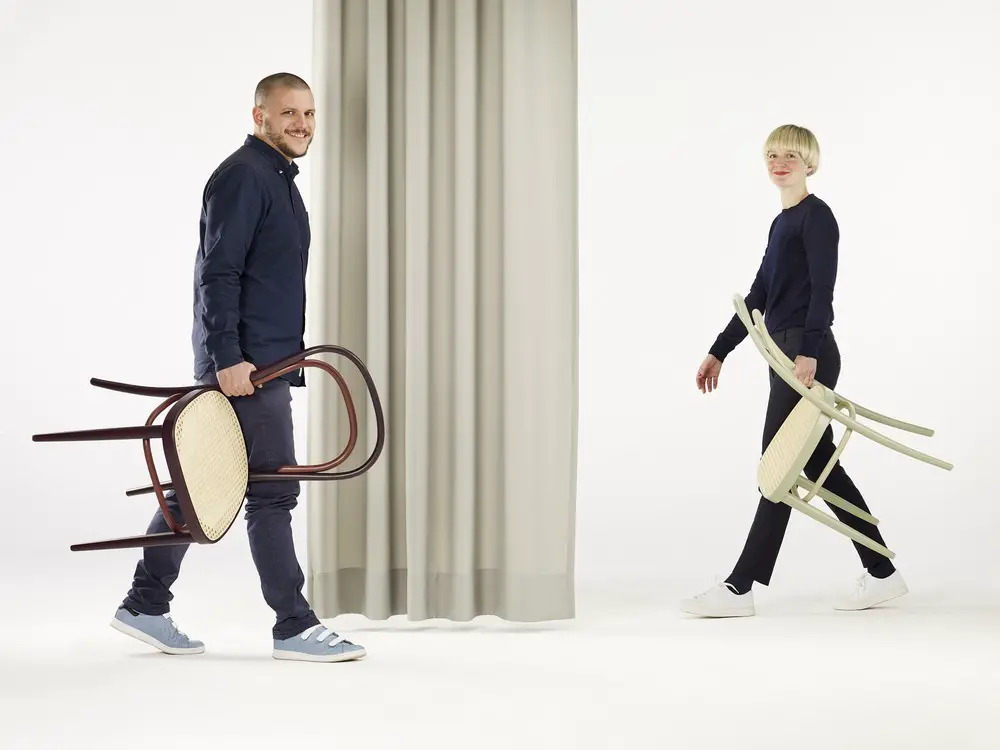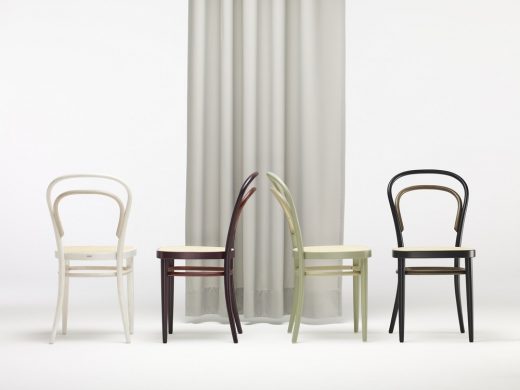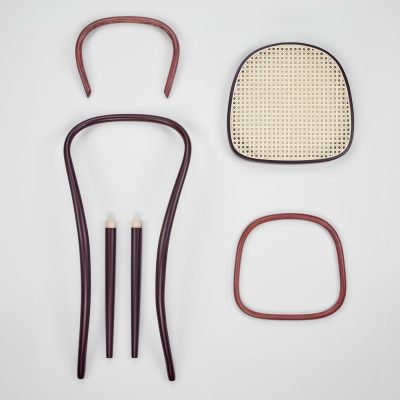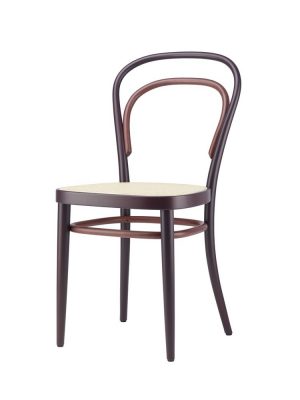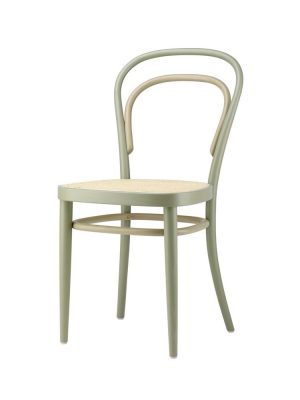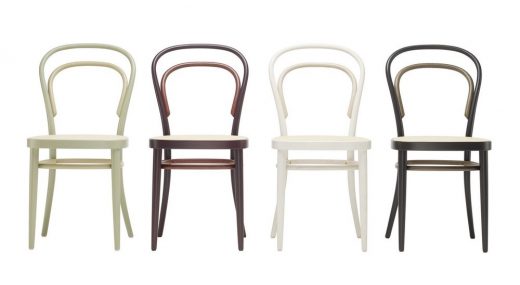The Iconic 214 Chair, Classic German Furniture Re-Interpreted, Images, Eva Marguerre, Marcel Besau
200 years of Thonet – 214 chair
The Iconic 214 Chair is revisited by Studio Besau Marguerre
25 Feb 2019
The Iconic 214 Chair
The subtle distinction: a smart colour concept for a design icon Design no. 14 (today 214): Michael Thonet (1859), re-interpreted by Studio Besau Marguerre (2019)
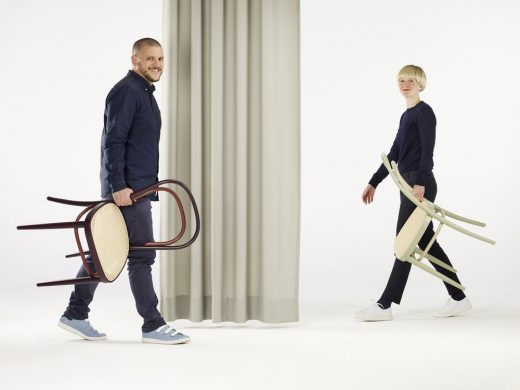
photo © Thonet Constantin Meyer, Koeln
At the occasion of the company’s 200th anniversary, Eva Marguerre and Marcel Besau created a special version of the famous Thonet Coffee House Chair 214. This icon will be available exclusively in 2019 in four contemporary two-tone colour versions: in black, white, velvet red and sage.
Their special feature: the connecting elements of the chair are stained several shades lighter than the seat ring and legs. The play of colours attracts the eye to the ingenious, minimalistic construction and, at the same time, transports its classic silhouette into a contemporary context. The natural look of the stains creates a translucent effect and the contemporary interpretation of classic colours creates a modern look.
The Thonet principle
Six parts, ten screws and two nuts: The design of the Thonet Coffee House Chair No. 14 (today 214) can be summed up with this formula. Michael Thonet did not need more in Vienna in 1859 to create one of the most successful industrial products ever and a classic of design history.
With this icon of modern furniture design, he established an example for what the much-quoted “reduction to the essential” really means, and at the same time established the foundation for serial mass production. Disassembled into its individual parts, 36 chairs could be packed into a shipping crate – and shipped and sold throughout the world. Colour nuances raise awareness for the essential
With their colour concept, Eva Marguerre and Marcel Besau raise awareness of chair 214’s essential and revolutionary construction, and thereby of the Thonet brand’s DNA. Based loosely on Charles and Ray Eames’ famous quotation “The details are not the details, they make the product”, their play of colours makes the chair’s construction visible. With the assistance of the two-tone concept, the individual parts of the chair become subtly distinct through soft colour nuances. Eva Marguerre and Marcel Besau: “The iconic nature of the chair is emphasized.”
The colour concept of the stains represents a spectrum of rather neutral, discrete shades in combination with nuances of strong character. The versions two-tone white and two-tone black look simple and elegant and fit in with any interior. The two-tone velvet red version brings back memories of 19th century coffee houses. In the anniversary edition, the classic red is juxtaposed with the fresh nuance of the bright sage green, lending a bright atmosphere to the interior.
The 214 in interiors: a graphic moment in spaces
Eva Marguerre and Marcel Besau were especially fascinated with the curved shapes of the 214: “For us, the central theme of the Thonet brand are the radii and round shapes of bent wood and tubular steel. We emphasize the shape of the 214, the curve of its backrest, with our colour concept – which creates a graphic effect.”
And they add: “We always think in an interdisciplinary way, and we always imagine products in a context. In the case of the 214, we naturally conceived a use in cafés – and this is precisely where we believe this chair still belongs today! The graphic moment plays a role for this purpose: The placement of many chairs in a space creates repetition. This makes the beauty of the backrests graded in the colour nuances visible – and thereby the beauty of the chair itself.”
The versions in detail
The anniversary edition of the 214 is made of beech wood. The seat is available with stretched wicker cane. The available stain colours of the anniversary edition are two-tone black, two-tone white, two-tone sage, and two-tone velvet red.
Thonet – future-oriented furniture design with a long tradition
The unique success story of Thonet began with the work of master carpenter Michael Thonet. Since establishing his first workshop in Boppard on the River Rhine in 1819, the name Thonet has stood for high-quality, innovative and elegant furniture. The breakthrough came with the iconic chair No. 14, the so-called Vienna Coffee House Chair: the pioneering technique of bending solid beech wood for the first time enabled the mass production of chairs.
The second milestone in design history was the tubular steel furniture by the famous Bauhaus architects Mart Stam, Ludwig Mies van der Rohe and Marcel Breuer in the 1930s. At the time, Thonet was the world’s largest producer of these tubular steel furniture designs, which are considered timeless today.
For the company today, the continuous process of innovation stands in the foreground alongside a focus on tradition and fine craftsmanship. Thonet collaborates with renowned national and international designers – in addition, some of the furniture is designed by the in-house Thonet Design Team.
All of the furniture is produced in the company-owned manufacturing facility, and, following the motto “Individuality is our standard”, custom-tailored solutions are part of everyday life in Frankenberg. Chief Executive Officer Brian Boyd together with Chief Operating Officer Michael Erdelt and Creative Director Norbert Ruf manage the company at the corporate head offices and production site in Frankenberg/Eder (Germany).
The descendants of Michael Thonet, the fifth and sixth generations, are actively involved with the company’s business as partners and sales representatives.
200 years of Thonet: the iconic 214 chair is revisited by Studio Besau Marguerre images / information received 250219
Location: Frankenberg an der Eder, Waldeck-Frankenberg district, Hesse, Germany
Architecture in Leipzig
Leipzig Buildings
Leipzig Architecture Designs – chronological list
Paulinum University
Architects: Design Erick van Egeraat
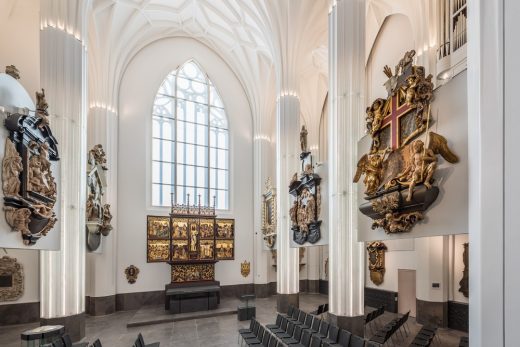
photo courtesy of architects
Paulinum University Leipzig Building
St. Trinitatis Church
Design: Schulz und Schulz
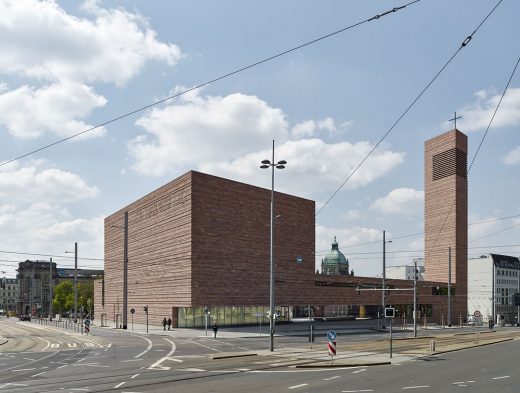
photo : Stefan Müller, Berlin (http://stefanjosefmueller.de)
St. Trinitatis Church Leipzig
Modern Architecture
Modern Architecture

photograph by Rohmer at en.wikipedia
German Architecture
Comments / photos for the 200 years of Thonet: the iconic 214 chair is revisited by Studio Besau Marguerre – page welcome
Website: Thonet

